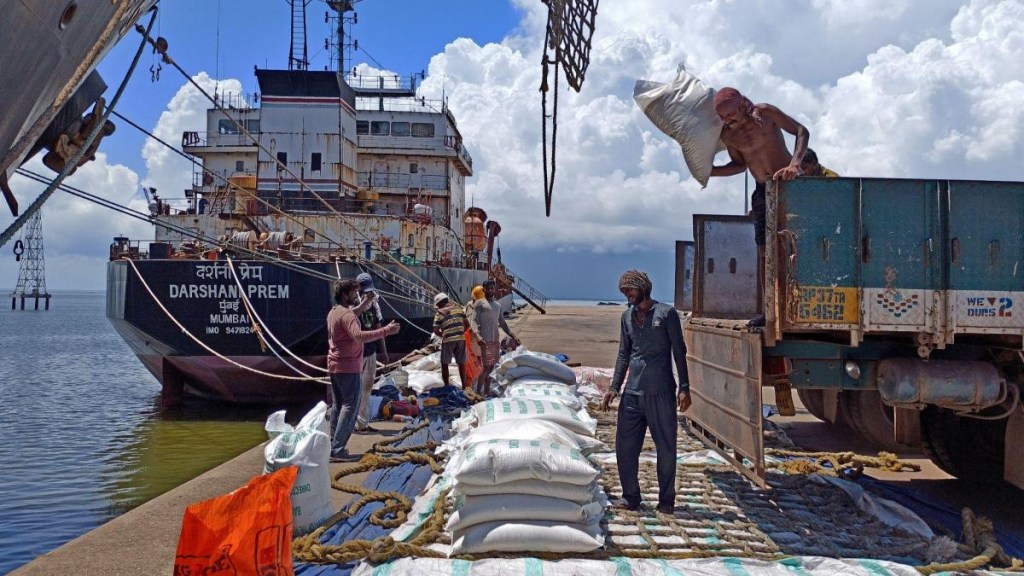By Ashok Gulati & Ritika Juneja,
Agricultural exports in FY24 touched $48.9 billion, registering 8% decline from $53.2 billion in FY23. This is significantly short of the ambitious target of $60 billion set by the Narendra Modi government for 2022. Not only this, but the growth momentum in agricultural exports during the 10 years of the Modi government seems to have lost steam, dropping from an annual average growth rate of 20% during the United Progressive Alliance (UPA) period (FY05-FY14) to a meagre 1.9% during FY15-24. In absolute terms, while India’s agri exports surged from $8.7 billion in FY05 to a whopping $43.3 billion in FY14, a vault jump of almost 500%, they only lurched thereafter, reaching $48.9 billion by FY24 (see graphic). This indicates a decline in trade surplus, from a peak of $27.7 billion in FY14 to $16 billion in FY24. Had the growth momentum under the UPA been sustained during the National Democratic Alliance (NDA) period, agricultural exports could have reached the $200-billion mark today. Since they have strong implications for the farming community’s income, there is an urgent need to chalk out a new strategy for reviving agri exports. This requires a deeper dive into the structure of our agri exports and reasons behind their sluggish growth during the NDA regime.
It is important to note that rice holds the top position in India’s agri exports basket, valued at $10.4 billion from 16.3 million tonnes (MT). This represents roughly 21% of the total value of agri exports in FY24. Following rice are marine products ($7.3 billion), constituting 15% share; spices ($4.25 billion) with 9% share; bovine meat ($3.7 billion) with 8% share; and sugar ($2.8 billion) accounting for 6% of the total share.
Indian agri exports are influenced by two main factors: how the global prices of agri produce are behaving; and how liberal is our agri export policy. When global prices are on the upswing, Indian agri exports also surge, as was the case in the UPA period. But when global prices fall, our price-competitiveness also gets blunted and agri exports suffer, as was the case in the first five years of the Modi government.
Besides global price dynamics, export restrictions and outright bans on sensitive commodities like rice, wheat, sugar, and onions lately have significantly impacted agri exports, driven primarily by concerns about domestic food inflation. This began with the ban on wheat exports on May 13, 2022, followed by restrictions on sugar exports in June 2022. On July 20, 2023, exports of non-basmati white rice and broken rice were prohibited. On August 25, 2023, a 20% duty was imposed on parboiled non-basmati rice exports, along with minimum export price (MEP) on basmati rice, initially set at $1,200/tonne and later reduced to $950/tonne in October. Recently, while the export ban on onions was lifted, it was replaced with a 40% duty, in addition to MEP of $550/tonne.
Export restrictions on rice offer valuable policy lessons. As India announced its rice export restrictions, the international price of rice (Thailand, 25% broken) surged by approximately 25%, from $494/tonne in April-June 2023 to $620/tonne in January 2024. This helped exporters of basmati rice and parboiled rice get better price realisation. Despite 27% drop in physical rice exports from 22.3 MT in FY23 to 16.3 MT in FY24, the value realisation only decreased by 6%, from $11.1 billion to $10.4 billion. Here is a policy lesson: in a global market of around 53 MT, if India exports say 22 MT or more rice, it will bring down global prices to Indian price levels. Trade theory suggests an optimal export tax to ensure marginal revenue from additional exports does not fall. Our research indicates India’s optimal rice export quantity should be around 15-16 MT. Beyond this, additional exports will yield diminishing marginal returns, i.e. India will have to export more quantity to get the same export revenue. That is not a wise policy. A prudent policy option would be to impose 15% export duty on common and parboiled rice, alongside lifting the outright export ban.
In case of rice, which is almost 65% irrigated, there is also a concern of depleting groundwater, especially in the Punjab-Haryana belt where power is free and fertilisers are highly subsidised. It is widely recognised that producing one kilogram of rice necessitates 3,000-5,000 litres of water for irrigation, depending on the topography. Assuming an average water usage of around 4,000 litres per kilogram of rice, with roughly half of it replenishing groundwater, exporting 16.3 MT of rice effectively means exporting 32.6 billion cubic metres of water. We must recognise that high subsidies on power and fertilisers confer artificial competitive advantage, but leads to ecological disaster in Punjab and Haryana.
Essentially, true export competitiveness hinges on boosting productivity and achieving more with fewer resources. This goal demands significant investments in agriculture, including research and development, seeds, irrigation, fertilisers, and adopting resource-efficient farming practices like precision agriculture, micro irrigation, and fertigation. These investments can drive down per-unit costs, enhance global competitiveness, increase exports, improve farmers’ profitability, as well as protect the environment.
The case of onion is unique. The government announced opening up exports just before the polling in Maharashtra, but put very high MEP with 40% export duty. Farmers are selling onions at Rs 15/kg, not enough to recover their costs, and they are deprived of export opportunity. All this shows that the government policy has consumer bias, which implicitly becomes anti-farmer. This needs to change if we want to augment farmers’ incomes.
Ashok Gulati is Infosys chair professor and Ritika Juneja is a fellow, ICRIER.
Disclaimer: Views expressed are personal and do not reflect the official position or policy of Financial Express Online. Reproducing this content without permission is prohibited.

